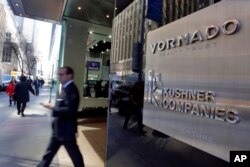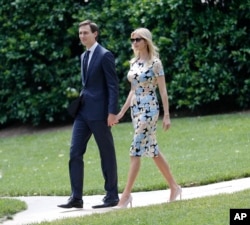A grand plan once spearheaded by Jared Kushner to rescue the biggest deal in his career by razing a Fifth Avenue skyscraper and building luxury apartments in its place is all but dead, the co-owner of the building said Tuesday.
The comments from Vornado Realty Trust CEO Steven Roth suggest that Kushner's most ambitious purchase will continue to bleed money - tens of millions a year - as a deadline for repayment of the giant mortgage on the office building nears. Kushner sold his personal interest in the tower, the family's flagship property and headquarters, before joining the White House as a senior adviser to his father-in-law, President Donald Trump.
Kushner bought the famed aluminum-clad skyscraper at 666 Fifth Avenue for a record $1.8 billion a decade ago when he was CEO of Kushner Cos., at the time mostly known for thousands of garden apartments in suburbia. Then he almost lost the building to lenders. Roth swept in with a rescue plan in 2011, offering cash in exchange for a big ownership stake.
The outlook for the office section of the building has not improved lately. Its 1.4 million square feet of office space is nearly a third empty and the Kushners and Roth must pay back a $1.2 billion mortgage in a little over a year.
While the clock is ticking for the Kushners, the opposite is true for Roth.
The Kushner Cos. is privately held and small compared with the company that Roth heads, the publicly traded Vornado Realty Trust, which has stockpiled hundreds of millions in cash. Roth can afford to wait until the last minute and, some analysts say, perhaps grab a bigger ownership stake in any crisis.
“The worse this thing turns out,” said Joe McBride, a project manager at research firm Trepp LLC, “the higher the chance that Vornado can take ownership of the property at lower entry.”
In a conference call with Vornado investors on Tuesday, Roth described the building as “overleveraged,” meaning it owes too much. Referring to the Kushner plans to tear down the building, he said “it's likely that those are not feasible” and that the building will probably remain offices.
Vornado had no other comment for this article. A spokesman for the Kushner Cos. did not immediately reply to a request for comment.
The Kushner Cos. had hoped to construct a tower where the Mad Men-era offices now stand, a gleaming building about twice as high and featuring luxury condominiums on most of floors.
The plan looked impressive on paper, with drawings by the late architect Zaha Hadid. But Roth reportedly has never embraced the concept. Among other problems, it would require billions of dollars from outside investors and would allow corporate tenants to leave the building when their leases run out so it can be demolished, leaving less money to pay the bills.
The hunt for billions has turned up nothing so far and, given Roth's comment, it looks likely the Kushners may have to reverse course, leaving the offices at 666 Fifth Avenue as they are.
The family had been negotiating with Anbang Insurance, a Chinese company with close ties to the ruling Communist party there. But Democrats in Congress and good-government watchdogs complained that China could use the investment as leverage with the White House, and negotiations were called off in March.
Talks with a Qatari billionaire have also ended, a Kushner Cos. spokesman recently confirmed. And Bloomberg has reported the Kushners have also gotten nowhere with other potential partners, including a South Korean government fund, a French billionaire and a Saudi investor.
Meanwhile, the finances of the building have only gotten worse.
When Jared Kushner bought it, 6 percent of the offices were empty. Now 30 percent are empty as leases are allowed to run out and tenants leave. Kushner long ago sold the retail space at the bottom of the building, but the interest rate on the $1.2 billion mortgage for the offices has steadily climbed from 3 to 5.5 percent in just four years.
Adding to the troubles, the luxury condo market has shifted recently, undermining a key assumption behind the raze-and-rebuild plan. There is a glut of luxury apartments in Manhattan now, prices are falling and they are taking longer to sell.
Looming above all this is a deadline. Lenders are expecting their $1.2 billion back, plus another $200 million in other charges, in February 2019 - 15 months away. If they don't get the money, they can foreclose on the property.
One idea is to sell the offices, but that might not be a good solution. Jed Reagan, a commercial real estate analyst at Green Street Advisors, doesn't think the offices are worth as much as the debt. And fixing up the offices to make them more appealing could cost a lot, too.
“This office building has a lot vacancies now, and there is quite a bit of deferred capital maintenance,” Reagan said. “Even if you stick with the offices as is, that's going to take money to attract tenants.”
Just how much money the Kushners have to spend on the building is not clear because they don't release financial figures to the public. And their recent moves leave a cloudy picture.
They have been buying more properties lately, suggesting they have cash or at least access to lenders. The Kushner Cos. and two partners reportedly paid $340 million for the former Jehovah's Witnesses headquarters near the Brooklyn Bridge over a year ago. Four months later, the same group bought a nearby parking lot for $345 million. Then, in August, the company paid $190 million for garden apartments near Princeton, New Jersey.
The Kushners have borrowed heavily in some deals, though, and they nearly always bring partners to invest with them, so it's not certain how much has been pulled from the pockets of the family business.
No one is guessing about the resources available to Roth, though, and that he can use a crisis to his advantage, as he did in 2011 when he made his big move on the Fifth Avenue building.
Back then falling rents had sent the building's assessed value plunging, a reserve fund set up to pay interest on the mortgage was running dry and lenders had just hired a “special servicer” in anticipation of a default.
Roth pounced, getting a 49.5 percent stake in the office building above the retail stores for $80 million, along with other financial commitments. He also got a bit of a bonus. The $80 million would be treated as “preferred equity,” which meant it would earn interest like a loan, according to a Credit Suisse report.
The rate was 11 percent, remarkable at a time when borrowing rates had plunged to their lowest in decades.
On Monday, Vornado reported that it had it took in $1.5 billion in rent and fees from dozens of its properties in the first nine months of this year. Its cash holdings for an emergency or a big deal stand at $1.3 billion.
“They are a very patient poker player,” said Alex Goldfarb , a managing director of Sandler O'Neill & Partners. “And when they get the right opportunity, they will act.”










